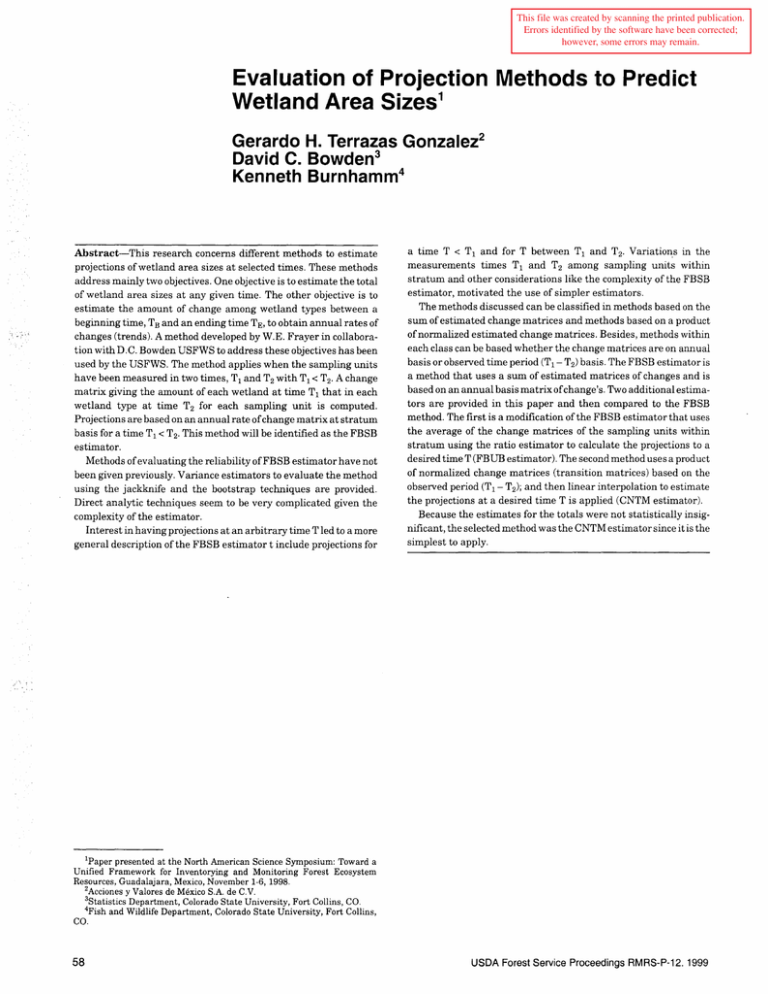Evaluation of Projection Methods to Predict Wetland Area Sizes
advertisement

This file was created by scanning the printed publication. Errors identified by the software have been corrected; however, some errors may remain. Evaluation of Projection Methods to Predict Wetland Area Sizes 1 Gerardo H. Terrazas Gonzalez2 David C. Bowden 3 Kenneth Burnhamm 4 Abstract-This research concerns different methods to estimate projections of wetland area sizes at selected times. These methods address mainly two objectives. One objective is to estimate the total of wetland area sizes at any given time. The other objective is to estimate the amount of change among wetland types between a beginning time, TB and an ending time T E , to obtain annual rates of changes (trends). A method developed by W.E. Frayer in collaboration with D.C. Bowden USFWS to address these objectives has been used by the USFWS. The method applies when the sampling units have been measured in two times, T 1 and T 2 with T 1 < T 2' A change matrix giving the amount of each wetland at time Tl that in each wetland type at time T 2 for each sampling unit is computed. Projections are based on an annual rate of change matrix at stratum basis for a time Tl < T 2. This method will be identified as the FBSB estimator. Methods of evaluating the reliability ofFBSB estimator have not been given previously. Variance estimators to evaluate the method using the jackknife and the bootstrap techniques are provided. Direct analytic techniques seem to be very complicated given the complexity of the estimator. Interest in having projections at an arbitrary time T led to a more general description ofthe FBSB estimator t include projections for a time T < T 1 and for T between T 1 and T 2' Variatio~s in the measurements times Tl and T2 among sampling units within stratum and other considerations like the complexity of the FBSB estimator, motivated the use of simpler estimators. The methods discussed can be classified in methods based on the sum of estimated change matrices and methods based on a product of normalized estimated change matrices. Besides, methods within each class can be based whether the change matrices are on annual basis or observed time period (T 1 - T 2) basis. The FBSB estimator is a method that uses a sum of estimated matrices of changes and is based on an annual basis matrix of change's. Two additional estimators are provided in this paper and then compared to the FBSB method. The first is a modification of the FBSB estimator that uses the average of the change matrices of the sampling units within stratum using the ratio estimator to calculate the projections to a desired time T (FB DB estimator). The second method uses a product of normalized change matrices (transition matrices) based on the observed period (T 1 - T 2); and then linear interpolation to estimate the projections at a desired time T is applied (CNTM estimator). Because the estimates for the totals were not statistically insignificant, the selected method was the CNTM estimator since it is the simplest to apply. Ipaper presented at the North American Science Symposium: Toward a Unified Framework for Inventorying and Monitoring Forest Ecosystem Resources, Guadalajara, Mexico, November 1-6,1998. 2Acciones y Valores de Mexico S.A. de C.V. 3Statistics Department, Colorado State University, Fort Collins, CO. 4Fish and Wildlife Department, Colorado State University, Fort Collins, CO. 58 USDA Forest Service Proceedings RMRS-P-12. 1999





